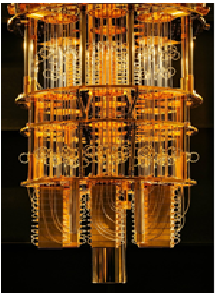博文
薛定谔的猫&时间不可逆性
|
原汁原味的Sci & Tech News weekly
Volume 2 19年5月15日
Editor: Dr. Collin F. Hu
卷首语:动物的行为总是让我们很好奇的。本期在animals领域选择了一篇关于猫的文章,内容是喵星人是否知道自己的名字?相信不少养猫的人士都有自己的答案。可如何去(不是凭声音大)说服众人呢?;在physics领域,选择了一篇在量子计算机中,通过操控两个量子态,(几乎)实现时间反转的梦想,可即使在这么简单的系统里,时间反转也非易事;在fun science这部分介绍了那个有名的薛定谔猫(又是猫!),它同时既是死的,又是活的,是什么意思?
animals:
记得在悉尼大学生命科学院访问时,曾经对一个研究生的报告很疑惑。她当时研究的好像是蝗虫在起飞的发育阶段与它某些行为的联系,我当时认为这是显而易见的事情。测量一下蝗虫的生理发育水平,看一下蝗虫的行为,就可以得到结果了。
我现在知道了,并非如我想的那样容易。为了“看一下”蝗虫的行为,他们用了一个特制的视频分析软件做大量的统计观察,然后进行统计分析得到的。而像喵星人这种高级的动物,根据其行为猜测其想法,更需要大量的统计数据。否则,如何避开某个喵星人的某些行为怪癖?
如果上升到人,这种行为学属于心理学范畴了。历史上,心理学为了自己的客观性苦苦的挣扎过。就是最近,心理学中几个最基础的实验又受到了质疑。但是,动物的行为是如此有趣。有谁不想知道“那只猫歪着个脑袋在想什么”?动物行为学,包括心理学,是很有趣的学问,但路阻且长。
所以,大家在读这类新闻时,出了知道新闻报道的主要内容外,同样需要关注它是如何得到这个结论的。以此,你可以判断,是否要相信这种说法。
Cats can recognize their names, but that doesn't mean they'll respond to you: Study
By Nala rogers ABC Apr 8, 2019

[What is it] Science has finally confirmed what cat owners knew all along: Cats know their own names. That doesn’t necessarily mean they respond when called (another thing cat owners could have told you). Cats in the new study turned their heads and ears toward the sound of their names, but generally didn't bother to vocalize back or communicate using their tails.
doesn’t necessarily mean 后面接一个从句,很常见的句式,通常是反面的意思。
“turned their heads and ears toward the sound” 好像不是很显著的动作,如何确定?
[How to do it] The findings came from a series of experiments using 16 to 34 cats in Japan. To get in the minds of their feline subjects, the researchers first made recordings of a human voice saying four common words with the same accent pattern and number of syllables as the cat's name, followed by the name itself.… Only a few of the cats in this experiment grew accustomed to the voice, reducing their response from the first to the fourth name. But those that did grow accustomed perked up again when they heard the fifth name, indicating that they knew it was their own.
a series of: 一系列的;
注意实验用的猫的数量,16 到 34 只,感觉统计量不够。而且,我们也应该注意实验中是如何定义“perked up”。
推荐读13遍的英语句子:
1, That doesn’t necessarily mean they respond when called (another thing cat owners could have told you).
2, The findings came from a series of experiments using 16 to 34 cats in Japan.
3, Only a few of the cats in this experiment grew accustomed to the voice, reducing their response from the first to the fourth name.
Physics:
“时间的不可逆性”是一个如此基本的话题,而且让人“想入非非”,在新闻上就看到过某个女孩想回到清朝(?)去当公主。
时间的不可逆性源于热力学第二定律,从统计物理学的角度看,时间的不可逆性源于宏观量级(10的23次方)个粒子的统计规律。可是,对于基本的牛顿力学,量子力学,时间是可逆的,表现在其基本的方程中,把时间t前加一个负号,方程仍然成立。(或更直观些,让你看一段小球撞墙(空气阻力很小),然后让你猜视频倒着放还是正着放)。
这篇《纽约时报》的文章告诉我们,撇开统计规律(来自统计物理),虽然量子理论的基本方程式中时间倒转成立,让量子计算机模拟的单个原子“年轻”了几个微秒。可是,对于在量子计算机上的人为的操控,即使是单个原子,实现起来非常复杂,更别提多个原子了。所以,时间不可倒转对于少数个体量子理论也是成立的。
For a Split Second, a Quantum Computer Made History Go Backward
By Dennis Overbye The New York Times May 8, 2019

[What is it?] In what amounts to a technological triumph for the aspiring Benjamin Buttons of the virtual world, a team of quantum physicists reported earlier this year that they had succeeded in creating a computer algorithm that acts like the Fountain of Youth.
amounts to:相当于,算得上;
Fountain of Youth:青春泉;
这段话其实就是一句,后半段比较容易读懂。前半段是对这项科研的通俗评价,意思是“算得上是真实世界的“Benjamin Buttons(一部电影,文章开头有介绍)””,但也很明白的说出了这是一个technological triumph。
[How to do it?] Using an IBM quantum computer, they managed to undo the aging of a single, simulated elementary particle by one millionth of a second. But it was a Pyrrhic victory at best, requiring manipulations so unlikely to occur naturally that it only reinforced the notion that we are helplessly trapped in the flow of time.
simulated elementary particle: 在量子计算机上,用一个量子位来模拟一个simulated elementary particle(可以处与0或1两种状态或其叠加态)。
Pyrrhic victory at best 最多是不切实际的胜利(因为不可能在自然界发生)。
[details] We seem to be at the mercy of the second law of thermodynamics, which states that disorder and complexity only increase in a closed system such as, say, the universe. … But the arrow of time takes its direction not only from big numbers. According to quantum theory, that paradoxical body of rules governing the subatomic universe, not even a single particle can reverse its own course through time.
at the mercy of: 原意是在**的恩惠中;在这儿的可以翻译为“在热力学第二定律的影响下”。不过,觉得整个宇宙的熵增大是一种很过时的看法(which states that disorder and complexity only increase in a closed system such as, say, the universe)。要知道在整个宇宙中,还有94%的暗能量和暗物质,我们对此的知识几乎为零。所以,这也是新的科学前沿。
推荐读13遍的英语句子:
1,We seem to be at the mercy of the second law of thermodynamics, which states that disorder and complexity only increase in a closed system such as, say, the universe.
2, Using an IBM quantum computer, they managed to undo the aging of a single, simulated elementary particle by one millionth of a second.
3,According to quantum theory, that paradoxical body of rules governing the subatomic universe, not even a single particle can reverse its own course through time.
本人对这项研究倒有一个疑问。是否还存在别的方法,可以很高效,很容易的把“原子”变回到过去?
Fun Sciences:
有老师,也有同学给我讲过薛定谔猫的实验,“如果你不看猫,你不知道它的死活。只有打开箱子后,你才知道它是死的还是活的”。我现在给他们的回答是,这不是很自然的事情吗?这样的事情能够吸引物理学家的注意达到85年吗?薛定谔猫有更微妙的含义在内。
Schrödinger's cat
Wikipedia 15 May 2019

[What is it] Schrödinger's cat is a thought experiment, sometimes described as a paradox, devised by Austrian physicist Erwin Schrödinger in 1935.It illustrates what he saw as the problem of the Copenhagen interpretation of quantum mechanics applied to everyday objects. The scenario presents a hypothetical cat that may be simultaneously both alive and dead, a state known as a quantum superposition, as a result of being linked to a random subatomic event that may or may not occur.
首先,这个薛定谔猫实验只能是一个思想实验,有太多的实验杂音(如猫的呼吸,猫的走动,甚至猫的存在),都使得这个实验不能完成。
但就这个思想实验来说,其核心是亚原子尺寸的事件是否发生。薛定谔是反对哥本哈根对量子力学的解释,即量子态可以叠加,直到实验者的观察使得波包塌缩。
[Copenhagen interpretation] A commonly held interpretation of quantum mechanics is the Copenhagen interpretation. … The experiment can be interpreted to mean that while the box is closed, the system simultaneously exists in a superposition of the states "decayed nucleus/dead cat" and "undecayed nucleus/living cat", and …
猫处在既死又活的状态,可以把它设想为“猫”的第三种状态。宏观物体处于这种状态过于离奇,不太好想象。实际上,量子规律可以在多大的宏观物体上显现,也是物理学家在研究的前沿领域。但是,对于微观粒子,如电子,如“薛定谔猫”一样,它可以同时在这儿,也可以在那儿,量子力学可以算出其几率来。
爱因斯坦就不同意这种解释,说了一句很有名的话“上帝不掷骰子”,指的就是这种几率解释。爱因斯坦终其一生都没有接受量子力学。
推荐读13遍的英语句子:
1. It illustrates what he saw as the problem of the Copenhagen interpretation of quantum mechanics applied to everyday objects.
2. The experiment can be interpreted to mean that while the box is closed, the system simultaneously exists in a superposition of the states "decayed nucleus/dead cat" and "undecayed nucleus/living cat".
https://blog.sciencenet.cn/blog-43547-1179180.html
上一篇:1,是男孩还是女孩? 2,”三人“ 婴儿? 3,光是什么?
下一篇:无人驾驶汽车 &孟母三迁的现代诠释